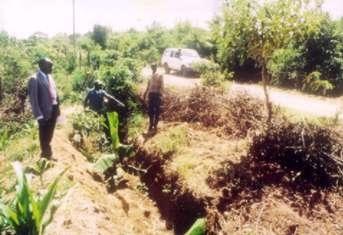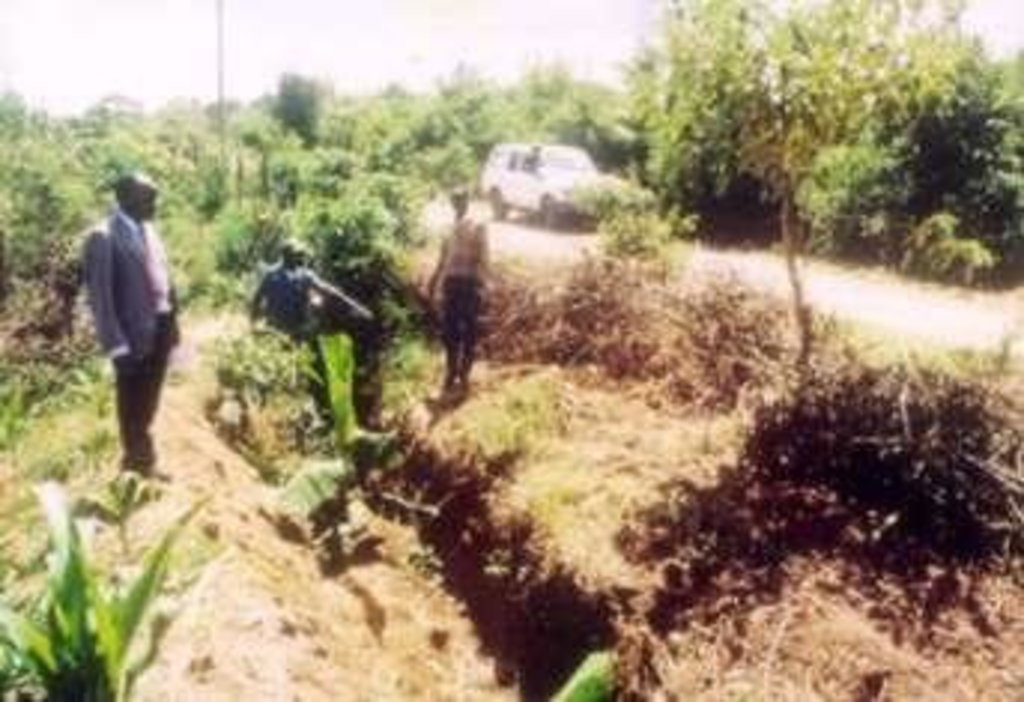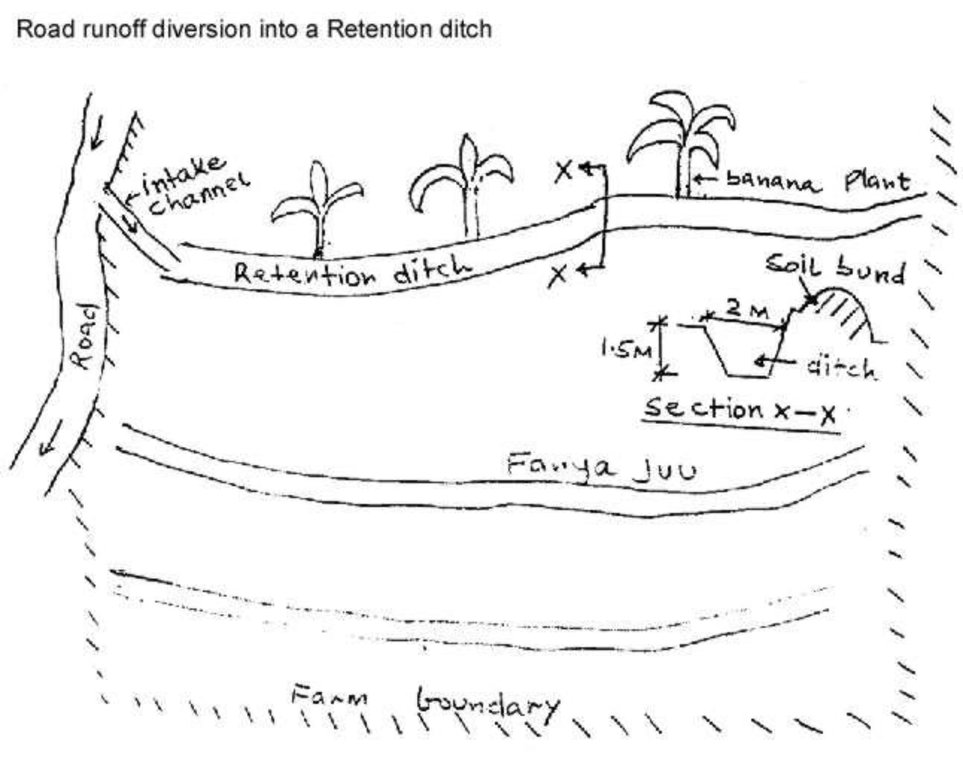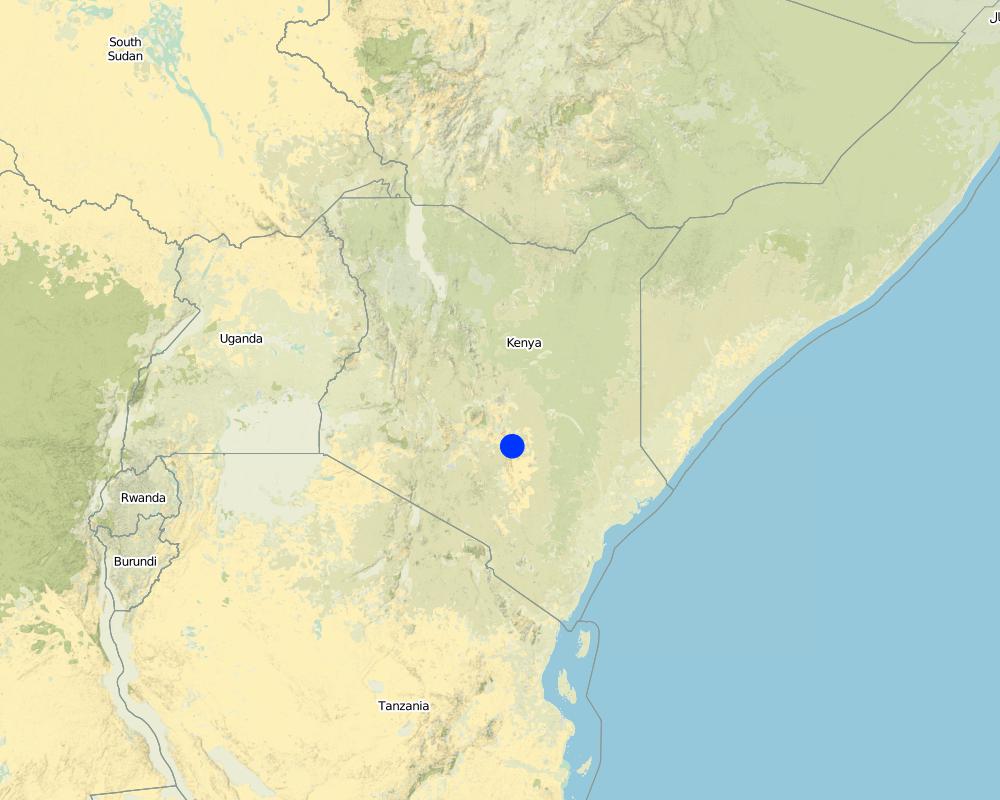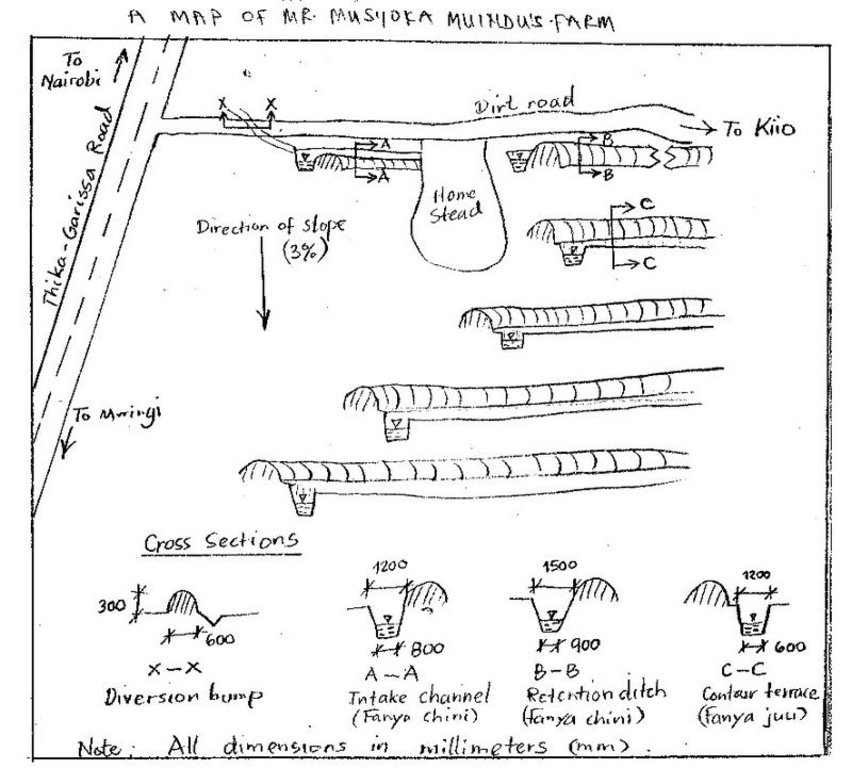Road runoff system - Mwingi [肯尼亚]
- 创建:
- 更新:
- 编制者: Kithinji Mutunga
- 编辑者: –
- 审查者: David Streiff, Alexandra Gavilano
Kuketha kiwuo
technologies_1483 - 肯尼亚
查看章节
全部展开 全部收起1. 一般信息
1.2 参与该技术评估和文件编制的资源人员和机构的联系方式
有助于对技术进行记录/评估的机构名称(如相关)
Ministry of Agriculture and Livestock Development of Kenya (MoA) - 肯尼亚1.3 关于使用通过WOCAT记录的数据的条件
编制者和关键资源人员接受有关使用通过WOCAT记录数据的条件。:
是
2. SLM技术的说明
2.1 技术简介
技术定义:
Diversion of runoff from the road and its environment into farm land
2.2 技术的详细说明
说明:
Diversion channel to harvest run off water from the road catchment. Individually constructed and maintained. The runoff water harvesting has a rainfall "multiplier " effect because it closes the gap between the actual precipition and the crop water requirement. Maintenance (reconditioning) is done mainly during the land preparation in the dry spell. The run is collected and distributed on the cultivated lad through canal systems. This technolgy is meant for semi arid conditions. It can also be applied in the good rainfall areas during poor seasons with crop moisture deficiency particularly during dry speells.
2.3 技术照片
2.5 已应用该技术的、本评估所涵盖的国家/地区/地点
国家:
肯尼亚
区域/州/省:
Eastern - Mwingi District
具体说明该技术的分布:
- 均匀地分布在一个区域
如果不知道精确的区域,请注明大致覆盖的区域:
- 100-1,000 平方千米
注释:
A farmer initiative technology
Map
×2.6 实施日期
如果不知道确切的年份,请说明大概的日期:
- 不到10年前(最近)
2.7 技术介绍
详细说明该技术是如何引入的:
- 通过土地使用者的创新
注释(项目类型等):
Own initiative and innovativeness
3. SLM技术的分类
3.1 该技术的主要目的
- 减少、预防、恢复土地退化
3.2 应用该技术的当前土地利用类型

牧场
注释:
Number of growing seasons per year: 2
Longest growing period in days: 105 Longest growing period from month to month: Oct - Jan Second longest growing period in days: 85Second longest growing period from month to month: Mar - May
Major land use problems (compiler’s opinion): Erratic rainfall for crop production and vegetative cover for livestock and declining fertility
Major land use problems (land users’ perception): Low rainfall, poor yields and little grass for livestock, and high cost of inputs
3.4 供水
该技术所应用土地的供水:
- 雨养
3.5 该技术所属的SLM组
- 引水和排水
3.6 包含该技术的可持续土地管理措施

结构措施
- S4:平沟、坑
注释:
Main measures: structural measures
3.7 该技术强调的主要土地退化类型

化学性土壤退化
- Cn:肥力下降和有机质含量下降(非侵蚀所致)

水质恶化
- Ha:干旱化
注释:
Main type of degradation addressed: Ha: aridification
Secondary types of degradation addressed: Cn: fertility decline and reduced organic matter content
3.8 防止、减少或恢复土地退化
具体数量名该技术与土地退化有关的目标:
- 减少土地退化
4. 技术规范、实施活动、投入和成本
4.1 该技术的技术图纸
技术规范(与技术图纸相关):
Technical knowledge required for field staff / advisors: low
Technical knowledge required for land users: low
Main technical functions: control of concentrated runoff: retain / trap, control of concentrated runoff: impede / retard, control of concentrated runoff: drain / divert, improvement of ground cover, increase of infiltration, increase / maintain water stored in soil, water harvesting / increase water supply
Secondary technical functions: sediment retention / trapping, sediment harvesting
Construction material (other): *Diversion ditch /COD gradient along the structure 0.25%
4.2 有关投入和成本计算的一般信息
其它/国家货币(具体说明):
Kenya Shilling
如相关,注明美元与当地货币的汇率(例如1美元=79.9巴西雷亚尔):1美元=:
27.0
注明雇用劳工的每日平均工资成本:
2.22
4.3 技术建立活动
| 活动 | 时间(季度) | |
|---|---|---|
| 1. | excavation | before rains |
| 2. | alignment/finishing | during the rains |
4.4 技术建立所需要的费用和投入
注释:
Duration of establishment phase: 12 month(s)
4.5 维护/经常性活动
| 活动 | 时间/频率 | |
|---|---|---|
| 1. | desilting | during rains/on demand |
| 2. | desilting | dry spell/once |
4.6 维护/经常性活动所需要的费用和投入(每年)
注释:
per metre length of the structure
4.7 影响成本的最重要因素
描述影响成本的最决定性因素:
slope determine the depth of the channel and soil type and distance from the road to the farm determines labour requirements
5. 自然和人文环境
5.1 气候
年降雨量
- < 250毫米
- 251-500毫米
- 501-750毫米
- 751-1,000毫米
- 1,001-1,500毫米
- 1,501-2,000毫米
- 2,001-3,000毫米
- 3,001-4,000毫米
- > 4,000毫米
农业气候带
- 半干旱
Thermal climate class: tropics
5.2 地形
平均坡度:
- 水平(0-2%)
- 缓降(3-5%)
- 平缓(6-10%)
- 滚坡(11-15%)
- 崎岖(16-30%)
- 陡峭(31-60%)
- 非常陡峭(>60%)
地形:
- 高原/平原
- 山脊
- 山坡
- 山地斜坡
- 麓坡
- 谷底
垂直分布带:
- 0-100 m a.s.l.
- 101-500 m a.s.l.
- 501-1,000 m a.s.l.
- 1,001-1,500 m a.s.l.
- 1,501-2,000 m a.s.l.
- 2,001-2,500 m a.s.l.
- 2,501-3,000 m a.s.l.
- 3,001-4,000 m a.s.l.
- > 4,000 m a.s.l.
关于地形的注释和进一步规范:
Slopes on average: Also gentle
5.3 土壤
平均土层深度:
- 非常浅(0-20厘米)
- 浅(21-50厘米)
- 中等深度(51-80厘米)
- 深(81-120厘米)
- 非常深(> 120厘米)
土壤质地(表土):
- 粗粒/轻(砂质)
- 中粒(壤土、粉土)
表土有机质:
- 低(<1%)
如有可能,附上完整的土壤描述或具体说明可用的信息,例如土壤类型、土壤酸碱度、阳离子交换能力、氮、盐度等。:
Soil depth on average: Also deep
Soil fertility is low
Soil drainage / infiltration is good
Soil water storage capacity is medium
5.6 应用该技术的土地使用者的特征
非农收入:
- 低于全部收入的10%
相对财富水平:
- 贫瘠
- 平均水平
机械化水平:
- 手工作业
- 畜力牵引
说明土地使用者的其他有关特征:
Population density: 10-50 persons/km2
Annual population growth: 2% - 3%
60% of the land users are average wealthy and own 60% of the land.
30% of the land users are poor and own 30% of the land.
10% of the land users are poor and own 10% of the land.
Off-farm income specification: employment outside the farm and area
5.8 土地所有权、土地使用权和水使用权
土地所有权:
- 社区/村庄
- 个人,有命名
土地使用权:
- 社区(有组织)
- 个人
6. 影响和结论性说明
6.1 该技术的现场影响
生态影响
水循环/径流
地表径流
SLM之前的数量:
80
SLM之后的数量:
10
土壤
土壤流失
SLM之前的数量:
12
SLM之后的数量:
2
6.4 成本效益分析
技术收益与技术建立成本相比如何(从土地使用者的角度看)?
短期回报:
积极
长期回报:
非常积极
技术收益与技术维护成本/经常性成本相比如何(从土地使用者的角度看)?
短期回报:
积极
长期回报:
非常积极
6.5 技术采用
- 1-10%
如若可行,进行量化(住户数量和/或覆盖面积):
30 households
在所有采用这项技术的人当中,有多少人是自发的,即未获得任何物质奖励/付款?:
- 91-100%
注释:
Comments on acceptance with external material support: estimates
10% of land user families have adopted the Technology without any external material support
30 land user families have adopted the Technology without any external material support
Comments on spontaneous adoption: estimates
There is a moderate trend towards spontaneous adoption of the Technology
Comments on adoption trend: more land users are harvesting runoff from the road
7. 参考和链接
7.1 信息的方法/来源
7.2 参考可用出版物
标题、作者、年份、ISBN:
Kenya population census. 1989.
可以从哪里获得?成本如何?
CBS, Nairobi
标题、作者、年份、ISBN:
SWC manual for Kenya. 1997.
可以从哪里获得?成本如何?
SWCB/MoA, Nairobi
标题、作者、年份、ISBN:
Farm managent handbook of Kenya. 1983.
可以从哪里获得?成本如何?
FMD/MoA, Nairobi
链接和模块
全部展开 全部收起链接
无链接
模块
无模块


